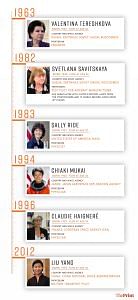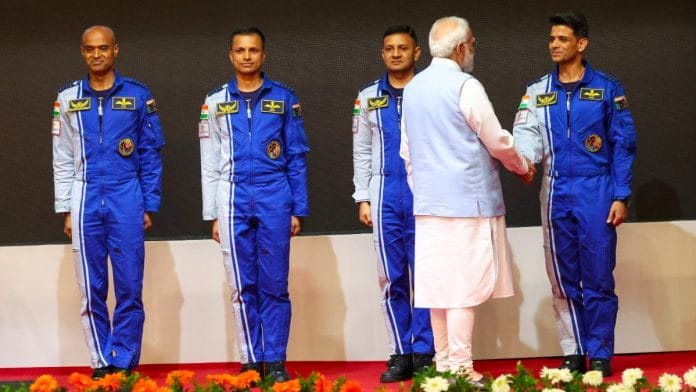As India gets ready to fly three astronauts into the Low Earth Orbit – the fourth nation in the world to do so after Russia, the United States and China – it’s worth noting that the proposed crew includes not a single woman. This comes at a time when women are no strangers to physically challenging professions – from fighter pilots to field infantry, and indeed, astronauts. Underlining the irony is that the country’s historic “still fresh in our memories” landing near the South Pole of the Moon, was co-led by a woman scientist.
The Indian Space Research Organisation (ISRO) and the Institute of Aerospace Medicine are pursuing the human spaceflight programme with gusto. Precursor tech demo missions are already underway to ensure mission safety and reliability before carrying out the first crewed mission. If all goes to plan, in 2025-26, ISRO’s crew capsule Gaganyaan will fly three male pilots on the human-rated LVM3 rocket to an orbit of about 400 km from the Earth for a three-day mission. For Gaganyaan’s debut flight, the astronaut candidates were required to be combat pilots of instructor grade. This all but ruled out women, who started to be inducted as combat pilots only in 2016. The four chosen Indian Air Force pilots have 20+ years of experience, which the young IAF female combat pilots don’t have yet.
Wing Commander Neelu Khatri (retired), co-founder of Akasa Air, applauded the four male ‘astronaut designates’ undergoing extensive training for the Gaganyaan mission. But she also told me: “While this is history in the making for India, it’s a pity that no woman combat pilot was even shortlisted despite the fact that their induction into the IAF began 8 years ago”.
It’s been nearly 40 long years since the first (and last) Indian citizen flew into space. In April 1984, Wing Commander Rakesh Sharma flew onboard Soyuz T-11 with two Soviet cosmonauts to the Salyut-7 orbital station as part of the Soviet Interkosmos programme. In 1997, Indian-born, American engineer Kalpana Chawla flew on Space Shuttle Columbia as a mission specialist. Twenty-seven years on, we still don’t have any Indian women flying or even training to fly to space.
Women astronauts aren’t new
In 2024, women astronauts are hardly novel. There are many women astronauts – active, retired, and reservists. A condensed review of some of the first female spacefarers:

Three of the six women firsts were in their early to mid-30s; two were in their late 30s/early 40s, and one was just 26. Only two of them were pilots, and none of them was a combat pilot. One was a test pilot who worked for an aircraft manufacturer, and the other was a military transport pilot. So, was it necessary for the Gaganyaan astronaut selection process to be that conservative, given the liberal precedent?
Even so, India has no dearth of commercial and military women pilots. In fact, the country has the highest number of women pilots in the world. As per the statistics of the Indian Directorate General of Civil Aviation (DGCA), women constitute 14 per cent of its pilot workforce compared to a global average of 6 per cent. That’s not all. Women pilots started joining the Indian Air Force (IAF) in non-combat roles more than 30 years ago, in 1993. Combat role induction began in 2016. Squadron leader Avani Chaturvedi was the first to join the combat ranks in 2016 along with two other women pilots. As of September 2020, an official IAF communique said that it had 110 female pilots of which nine were fighter jet pilots, 50 were helicopter pilots and 51 were transport pilots. According to Khatri, today there are 19 female fighter pilots in the IAF.
Also read:
The all-male pilot system is dated
The all-male-test-pilot-as-astronaut school of thought is a rather old one. NASA picked that path over half a century ago, when, in 1959, it selected seven male fighter pilots for its first human spaceflight programme, Project Mercury. Women pilots were not considered fit for the role and were not invited to apply. Without any other precedent, and the time’s reigning biases, it is unsurprising that fighter pilots, subject to the same kind of G-forces, were considered suitable candidates for spaceflight. The more experienced the better.
As we reflect on the historical context of astronaut selection, it is essential to recognize the contributions of women in space exploration. For instance, Kalpana Chawla, the first Indian-born woman in space, serves as a powerful reminder of the potential that remains untapped in the current selection processes.
However, inquiry into the system of selection began almost right away – in fact, a year prior, in 1958.
William Randolph Lovelace-II, a Harvard-educated physician, was appointed Chairperson of the NASA Special Advisory Committee on Life Sciences. As head of NASA’s Life Sciences, he played a vital role in astronaut selection for Project Mercury. In 1964, he was appointed NASA’s Director of Space Medicine. In 1959, Dr Lovelace started a privately funded programme to test and screen women pilots for spaceflight. He considered women well-suited for space travel because they were smaller and lighter and could easily fit into cramped space capsules.
Thirteen American women pilots successfully completed all of the same medical testing as the Mercury Seven men. While Lovelace called the project “Woman in Space Program”, the 13 women ultimately became known as the Mercury 13. This term was coined in 1995 by Hollywood producer James Cross, as a comparison to the male astronauts of Mercury 7.
The Mercury 13 women were not part of NASA’s official astronaut programme, and never flew in space as part of a NASA mission. These women were among those who lobbied the White House and US Congress to have women included in the astronaut programme. They testified before a congressional committee in 1962. These were all civilian pilots – it wasn’t until 1993 that Jeannie Leavitt became the first female American fighter pilot to be inducted into the United States Air Force.
Also read:
Ganganyaan could’ve been inclusive
By extrapolation, the Gaganyaan astronaut selection committee could have allowed both combat and non-combat female pilots from the IAF to apply. No excuses, really.
We have missed a great opportunity as a nation. We could have created history, had we allowed female IAF pilots to compete in the first round of astronaut selection. India, too, could have borrowed from an audacious and open-minded aerospace medicine pioneer like Dr Lovelace. It could have created a programme to put all of IAF’s female combat and non-combat pilots through the same battery of tests, physiological and psychological, to see how many made the cut. For those who believe in India’s women pilots, many of them would have qualified.
As India prepares to send its citizens into space on board its own vehicles, one cannot but see the absence of women from the crew as a huge missed opportunity. It could have inspired the country’s women and girls while acknowledging their vital contribution to the nation.
Dr Susmita Mohanty is a spaceship designer and a serial entrepreneur who has worked on human space exploration projects for 25+ years – with NASA, Boeing, and the European Space Agency. She now heads India’s space think tank Spaceport SARABHAI. She tweets @suz_moonwalker. Views are personal.
(Edited by Zoya Bhatti)






